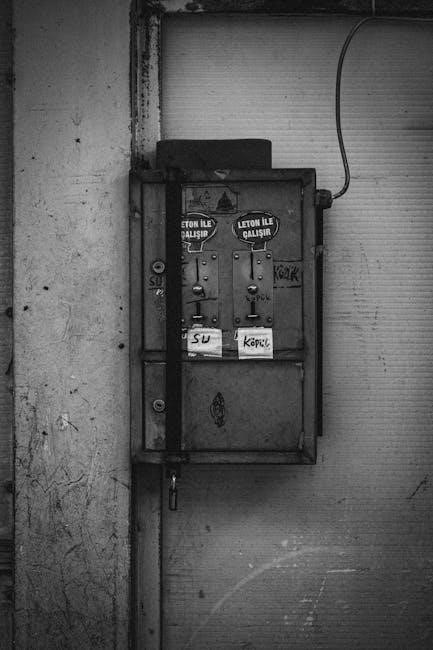The 2007 Toyota FJ Cruiser fuse box diagram is essential for understanding and maintaining your vehicle’s electrical systems. It provides a detailed guide for identifying and resolving issues efficiently.
Overview of the Toyota FJ Cruiser Fuse Box
The Toyota FJ Cruiser fuse box is a critical component of the vehicle’s electrical system, designed to protect and regulate power distribution to various components. It acts as a central hub, housing multiple fuses and relays that control essential functions such as lighting, electronics, and engine systems. The fuse box is divided into sections, each responsible for specific circuits, ensuring efficient power management. Understanding the layout and functionality of the fuse box is essential for diagnosing and resolving electrical issues. The fuse box diagram provides a detailed map of each fuse’s location and purpose, simplifying troubleshooting for owners and technicians alike. This system ensures safety by preventing electrical overloads and makes maintenance more accessible.
Importance of the Fuse Box Diagram for Troubleshooting
The fuse box diagram is an essential tool for diagnosing electrical issues in the 2007 Toyota FJ Cruiser. It provides a clear visual representation of the fuse layout and their corresponding circuits, making it easier to identify which fuse controls specific components. This diagram helps pinpoint the root cause of electrical malfunctions, such as blown fuses or faulty relays, saving time and effort. By referencing the diagram, owners and technicians can quickly locate and test the relevant fuse, ensuring accurate troubleshooting. It also reduces the risk of incorrect fuse replacements, which could lead to further damage or safety hazards. Regularly consulting the fuse box diagram promotes efficient and safe maintenance, keeping the vehicle’s electrical systems functioning properly. This resource is invaluable for both DIY enthusiasts and professional mechanics.

Location of the Fuse Boxes in the 2007 Toyota FJ Cruiser
The fuse boxes are located in two main areas: the instrument panel and the engine compartment. Both compartments provide easy access for maintenance.
Instrument Panel Fuse Box
The instrument panel fuse box in the 2007 Toyota FJ Cruiser is located on the driver’s side, beneath the dashboard. It is easily accessible and houses a series of fuses that control various electrical systems. This box typically contains up to 24 fuses, each assigned to specific functions such as interior lighting, audio systems, and electronic accessories. The fuses are labeled according to their purposes, making it easier to identify and replace them when necessary. A fuse puller tool is often provided in the glove compartment for safe removal and installation. The instrument panel fuse box is a critical component for maintaining and troubleshooting the vehicle’s electrical systems. Always refer to the fuse box diagram for accurate fuse identification and replacement. Proper handling ensures the longevity of the electrical components.
Engine Compartment Fuse Box
The engine compartment fuse box in the 2007 Toyota FJ Cruiser is located on the driver’s side of the engine bay, near the battery. It is secured in a protective housing and contains fuses that control essential systems such as the cooling fan, ABS, and power steering. This box is designed to withstand the harsher conditions of the engine compartment and is sealed to prevent moisture and debris from damaging the fuses. The fuses are organized by function, with labels on the fuse box cover for easy identification. A fuse puller tool is often included in the glove compartment for safe removal and replacement. Always consult the fuse box diagram to ensure proper fuse identification and installation. Proper maintenance of this fuse box is crucial for the vehicle’s reliability.

Types of Fuses Used in the 2007 Toyota FJ Cruiser
The 2007 Toyota FJ Cruiser uses three main types of fuses: Type A (low-power), Type B (medium-power), and Type C (high-power) for various electrical systems.
Fuses (Type A)
Type A fuses in the 2007 Toyota FJ Cruiser are designed for low-power electrical systems. These fuses are typically used for accessories like interior lights, power outlets, and small electronic components. They are characterized by their compact size and lower ampere ratings, usually ranging from 5 to 20 amps. Type A fuses are essential for protecting sensitive circuits from overload or short circuits. They are often found in the instrument panel fuse box and are easily identifiable due to their smaller dimensions compared to other fuse types. Proper identification of Type A fuses is crucial for troubleshooting, as using the wrong fuse can lead to system malfunctions or fire hazards. Always refer to the fuse box diagram to ensure correct replacement;
Fuses (Type B)
Type B fuses in the 2007 Toyota FJ Cruiser are designed for medium to high-power electrical systems. These fuses are commonly used for components such as the rear window defroster, power seats, and other moderately powered accessories. Type B fuses typically have ampere ratings ranging from 15 to 40 amps, making them suitable for systems that require more power than Type A fuses can handle. They are often located in the engine compartment fuse box, where higher-power systems are concentrated; Type B fuses play a crucial role in protecting these systems from overloads or short circuits. Proper identification and installation of Type B fuses are essential to ensure reliable operation and safety. Always consult the fuse box diagram to confirm the correct fuse type and rating for your specific application.
Fuses (Type C)
Type C fuses in the 2007 Toyota FJ Cruiser are designed for high-power electrical systems that require robust protection. These fuses are typically used for components such as the radiator fan, ABS system, and starter motor, which draw significant power. Type C fuses usually have higher ampere ratings, ranging from 20 to 50 amps, to accommodate the increased electrical demand of these systems. They are often located in the engine compartment fuse box, where high-power systems are concentrated. Proper installation and replacement of Type C fuses are essential to prevent damage to critical vehicle functions. Always refer to the fuse box diagram to identify the correct Type C fuse for your specific application. This ensures safe and reliable operation of your FJ Cruiser’s electrical systems.

Understanding the Fuse Box Diagram
Understanding the 2007 Toyota FJ Cruiser fuse box diagram is crucial for identifying and troubleshooting electrical systems. It provides a visual guide to locate fuses and their functions.
How to Read the Fuse Box Diagram
To effectively read the 2007 Toyota FJ Cruiser fuse box diagram, start by identifying the fuse box locations. The instrument panel fuse box is situated under the dashboard, while the engine compartment fuse box is in the engine area; Locate the diagram, typically found in the owner’s manual or as a PDF download. Begin by examining the layout, which visually represents each fuse and its corresponding circuit. Look for numbers or letters assigned to each fuse, which correlate to specific components such as headlights or the radio. Refer to the legend or key included on the diagram to understand the symbols used. Note the amperage ratings indicated for each fuse, crucial for selecting the correct replacement. Identify which fuses control essential systems like stop lights, headlights, and fuel injection. If a fuse is blown, match its number and rating to ensure proper replacement. For troubleshooting, trace the circuit connections shown on the diagram to isolate electrical issues. Some diagrams may include color-coded wires or lines to simplify tracing. Additionally, look for instructions on how to test fuses, possibly using a multimeter. Finally, consider labeling the diagram for future reference to enhance understanding and efficiency in troubleshooting. By systematically studying the diagram, you can identify and resolve electrical problems effectively.
Key Symbols and Markings on the Diagram
The 2007 Toyota FJ Cruiser fuse box diagram includes several key symbols and markings to guide users. Circles or rectangular boxes represent individual fuses, while lines connecting them indicate circuit relationships. A fuse with a diagonal line through it signifies a blown fuse. Arrows may denote power flow direction, helping trace electrical pathways. Color-coded lines differentiate between primary and secondary circuits. Symbols like a lightning bolt may indicate high-current components. Numbers or letters near fuses correspond to their ratings and purposes, found in the diagram’s legend. Additional markings, such as “ACC” for accessories or “IG” for ignition, clarify circuit functions. Understanding these symbols is essential for accurately interpreting the diagram and diagnosing electrical issues without confusion.

Troubleshooting Common Electrical Issues
Troubleshooting electrical issues in the 2007 Toyota FJ Cruiser often starts with checking blown fuses or faulty wiring. Referencing the fuse box diagram helps identify the correct fuse for specific components. Testing circuits and consulting a repair manual can guide further diagnosis. Always ensure proper tools and safety precautions are used when handling electrical systems to avoid damage or injury.
Identifying Blown Fuses
Identifying blown fuses in the 2007 Toyota FJ Cruiser requires a systematic approach. Start by locating the fuse boxes, as outlined in the fuse box diagram. Use the diagram to determine which fuse corresponds to the malfunctioning component. Remove the fuse in question using a fuse puller or pliers. Visually inspect the fuse for a broken wire or discoloration inside the glass. If the wire is broken, the fuse is blown. For type A, B, or C fuses, check continuity using a multimeter. A blown fuse will show no continuity. Always refer to the diagram to ensure you’re testing the correct fuse for the issue at hand. This method helps pinpoint electrical problems efficiently and safely.

Step-by-Step Fuse Replacement Guide
To replace a blown fuse in the 2007 Toyota FJ Cruiser, start by gathering the necessary tools: a fuse puller (or needle-nose pliers) and a replacement fuse of the correct type and amperage rating. Locate the fuse box using the diagram provided in the PDF guide. Open the fuse box cover and identify the blown fuse using the diagram’s labels. Pull out the blown fuse carefully with the fuse puller. Inspect the replacement fuse to ensure it matches the type (A, B, or C) and rating of the original. Insert the new fuse into the same slot, ensuring it clicks securely into place. Replace the fuse box cover and test the affected electrical system to confirm the issue is resolved. Always disconnect the battery or ensure the ignition is off before starting the replacement process to avoid electrical shocks or damage.

Critical Fuse Assignments in the 2007 Toyota FJ Cruiser
Critical fuses control essential systems like stop lights, headlights, and the multiport fuel injection system. Their proper function ensures safety, prevents engine issues, and maintains key vehicle operations.
Stop Lights and High Mounted Stoplight Fuse
The stop lights and high mounted stoplight fuse are crucial for safety, controlling the brake lights and the center high-mounted stoplight. These lights signal braking to other drivers, preventing accidents. The fuse for these lights is typically located in the instrument panel fuse box. If the fuse blows, the stop lights will fail, increasing the risk of a collision. Drivers should check the fuse box first if the stop lights malfunction. Replacing the fuse with the correct amperage rating is essential to restore functionality. Proper maintenance ensures these critical safety features operate reliably, enhancing overall vehicle safety on the road.
Headlight Fuses (Low Beam)
The low beam headlight fuses in the 2007 Toyota FJ Cruiser are essential for proper lighting during nighttime driving. These fuses are typically located in the engine compartment fuse box and are responsible for controlling the power supply to the low beam headlights. If a fuse blows, the low beams will not illuminate, reducing visibility and increasing the risk of accidents. Drivers should check the fuse box for blown fuses if the low beams fail. Replacing the fuse with the correct amperage rating is crucial to restore functionality. Proper maintenance of these fuses ensures reliable operation of the low beam headlights, enhancing safety and visibility while driving at night. Always consult the fuse box diagram for accurate fuse identification and replacement procedures.
Multiport Fuel Injection System Fuse
The multiport fuel injection system fuse is a critical component in the 2007 Toyota FJ Cruiser, ensuring proper fuel delivery to the engine. This fuse is typically located in the engine compartment fuse box and is responsible for powering the fuel injectors and related control systems. If this fuse blows, the engine may experience poor performance, rough idling, or even fail to start. Drivers should consult the fuse box diagram to locate and inspect this fuse if fuel system issues arise. Replacing it with the correct amperage rating is essential to maintain optimal engine operation. Proper functioning of this fuse is vital for reliable fuel injection, which directly impacts the vehicle’s performance and efficiency. Always refer to the diagram for accurate fuse identification and replacement guidance.

Safety Precautions When Working with Fuses
Always disconnect the battery before handling fuses to prevent electrical shocks or short circuits. Use insulated tools and avoid touching live circuits. Wear protective gloves and eyewear. Never force a fuse into the box or use incorrect amperage ratings, as this can cause fire hazards. Ensure the ignition and all electrical systems are off before starting work. Properly secure loose clothing and avoid working in wet conditions to minimize risks. Follow the manufacturer’s guidelines for fuse replacement and installation. Keep children away from the work area to ensure safety. Regularly inspect fuses and connections to prevent overheating or damage. Always test systems gradually after repairs to identify potential issues early.
Warning: Avoiding Fire Hazards
When working with the 2007 Toyota FJ Cruiser fuse box, it’s crucial to avoid actions that could lead to fire hazards. Always disconnect the battery before starting repairs to eliminate the risk of electrical shorts. Never use a fuse with a higher amperage rating than specified, as this can cause overheating and potentially start a fire. Avoid touching electrical components with metal objects, as this can create sparks. Do not bypass fuses or use improper substitutes, such as copper wire, as this can overload circuits; Keep flammable materials away from the work area. If a fuse is damaged or blown, replace it with the correct type and rating. Never force a fuse into the box, as this can damage the fuse holder and create a fire risk. Always refer to the official Toyota fuse box diagram for accurate guidance.
Proper Fuse Installation Guidelines
Proper fuse installation is essential for maintaining the electrical integrity of your 2007 Toyota FJ Cruiser. Always disconnect the battery before replacing a fuse to prevent electrical shocks or short circuits. Use only the fuse type and amperage rating specified in the official fuse box diagram. Handle fuses by the plastic body, avoiding contact with the metal parts to prevent damage. Ensure the fuse is fully seated in the holder to maintain proper electrical connections. Never overload a circuit by installing a fuse with a higher amperage than recommended. After installation, reconnect the battery and test the affected system to confirm functionality. Keep spare fuses of the correct type in your vehicle for emergencies. Refer to the Toyota FJ Cruiser fuse box diagram for precise guidance on fuse locations and ratings.

Additional Resources for the 2007 Toyota FJ Cruiser
Access the official Toyota FJ Cruiser fuse box diagram PDF from Toyota’s website or authorized dealerships. Join forums like FJ Cruiser Forums or Facebook groups for owner-shared diagrams and troubleshooting tips. Third-party websites such as Autozone or O’Reilly Auto Parts often provide downloadable fuse box diagrams for the 2007 model. Ensure the PDF matches your vehicle’s specific configuration and model year for accuracy. These resources enhance your ability to diagnose and repair electrical systems effectively.
PDF Download Guide for Fuse Box Diagrams

To obtain a detailed PDF of the 2007 Toyota FJ Cruiser fuse box diagram, visit Toyota’s official website or authorized dealership resources. Search for “2007 Toyota FJ Cruiser fuse box diagram PDF” on trusted automotive websites or forums. Ensure the PDF is specific to your vehicle’s model year and configuration. Websites like Autozone, O’Reilly Auto Parts, or Toyota’s service portal often provide downloadable diagrams. Verify the source for accuracy to avoid incorrect fuse assignments. This guide will help you locate and identify fuses, ensuring proper troubleshooting and repairs. Always cross-reference the PDF with your vehicle’s specifications for reliability.
Online Communities and Forums for FJ Cruiser Owners
Online forums and communities are invaluable resources for 2007 Toyota FJ Cruiser owners seeking fuse box diagrams or troubleshooting guidance. Websites like Toyota Nation, FJ Cruiser Forums, and Reddit’s r/FJCruiser provide platforms for owners to share knowledge, DIY guides, and direct links to PDF diagrams. These communities often include discussions on common electrical issues and tips for interpreting fuse box layouts. Members frequently post high-quality scans or detailed explanations of fuse assignments, making it easier to locate and repair issues. Engaging with these forums can also connect you with experienced owners who offer real-time advice and support.
Understanding the 2007 Toyota FJ Cruiser fuse box diagram is essential for diagnosing and resolving electrical issues efficiently. Always refer to the diagram for accurate repairs and maintenance.
Final Tips for Using the Fuse Box Diagram Effectively
To maximize the effectiveness of the 2007 Toyota FJ Cruiser fuse box diagram, always cross-reference it with your owner’s manual for specific details. Use the diagram to identify fuse locations quickly and accurately. Keep a printed or digital copy handy for easy access during repairs. When troubleshooting, start by checking the most common fuses related to the issue. Ensure you use the correct fuse type and rating to avoid damage. Disconnect the battery before making any changes to prevent electrical shocks. Regularly inspect fuses for signs of wear or damage. By following these steps, you can resolve electrical issues efficiently and safely, ensuring your FJ Cruiser runs smoothly.
